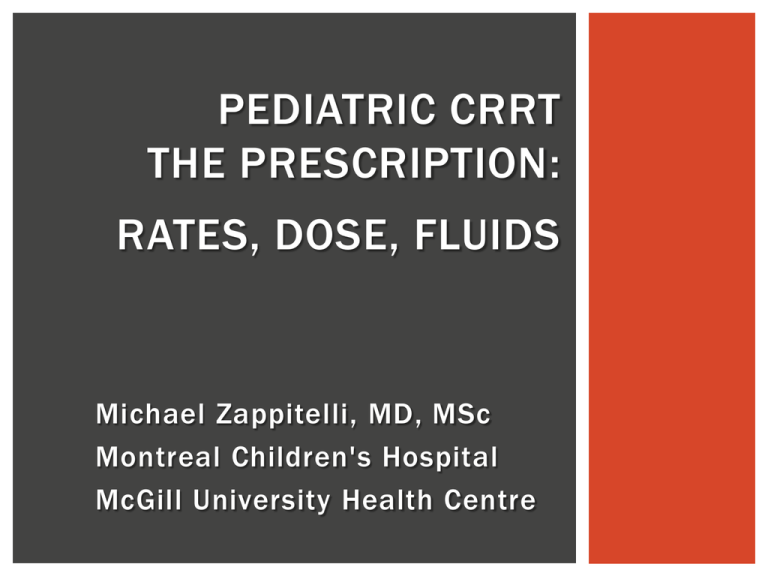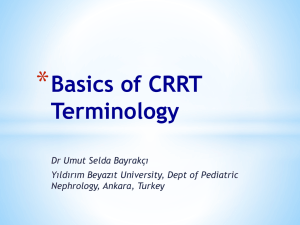Prescription Rates Dose Fluids - Pediatric Continuous Renal
advertisement

PEDIATRIC CRRT THE PRESCRIPTION: RATES, DOSE, FLUIDS Michael Zappitelli, MD, MSc Montreal Children's Hospital McGill University Health Centre OVERVIEW Rates & Dose Blood flow Dialysis fluid Replacement fluid Ultrafiltration rate Fluids Suggested Not necessarily a recipe BLOOD FLOW RATE Qb Age & weight – based Promote circuit lifespan + patient stability: clots vs alarms Highly access-dependent Aim return access pressures ~ < 200 mmHg, no alarms May be machine – dependent Prisma: 180 ml/min Prismaflex & Aquarius: 450 ml/min Start lower and increase by about 10 minutes (?) BLOOD FLOW RATE No set “perfect rates” From 3 to ~10 ml/kg/min, depending on age: Examples: 0-10 kg: 25-50ml/min 11-20kg: 80-100ml/min 21-50kg: 100-150ml/min >50kg: 150-180ml/min Based on previously most commonly used machine Neonates 8 to 12 ml/kg/min Children 4 to 8 ml/kg/min Older 2 to 4 ml/kg/min. Most not > 200 ml/min: not dangerous just not necessary BLOOD FLOW RATE May need to modify: Be aware of access and return pressure Visually inspect filter for clots Transmembrane pressure – may need to increase blood flow Filtration fraction SOLUTIONS Slow continuous ultrafiltration – none CCVHD – dialysis fluid for diffusive clearance CVVH – replacement fluid: replacing fluid you are removing to achieve solute clearance by convection CVVHDF – both Using these to correct metabolic abnormalities (remove) and prevent treatment-related metabolic abnormalities (replace). IDEAL SOLUTIONS Physiological/ compatible Composition: Peritoneal dialysis fluid? Hyperglycemia, metab acidosis Sodium: ~ 130 to 140 Soysal et al, Ped Neph, 2007 Reliable Chloride: ~105 to 120 dependent on other anions (HCO3) Pre-made IV solutions: Potassium: MOST Zero – need to add (some have) Inexpensive Magnesium: 1 to 1.5 mEq/L Saline, Lactated Ringers Glucose/Dextrose: 0 to 110 mg/dL Easy to prepare Multi-bag systems: why? Lactate: Most 0 to 3 mEq/L (35-40 mEq/L if lactate buffer) Custom-made solutions: Simple to storeBicarbonate: Local pharmacy; outsource Most 30-35 mEq/L Quick to the bedside Few ZERO Commercially available solutions: As low as 22 to 25 mEq/L Ready-bags (compartments) Widely available Concentrate added to bag Calcium: 0 to 3.5 mEq/L CHOOSING SOLUTIONS Cost (Storing, frequency of use) Anticoagulation: +/- calcium with citrate anticoagulation There are citrate based solutions and data Patient safety – patient volume? Does everyone prescribing really understand? Regulatory issues (dialysis versus replacement fluid....) Accusol Prismasate Some solutions are more flexible than others Normocarb Duosol Prismasol Hemosol BO ........... PHOSPHATE They WILL develop hypophosphatemia Can replace: IV boluses, TPN MANY add it to solutions – but no good data Worry about precipitation, calcium-magnesium binding How much too much? No good answer. Many 1.2-1.5 mmol/L Pharmacy versus nurse-based addition? ADDING PHOSPHATE Troyanov et al, Intens Care Med, 2004 Experiment Added 1.2 mmol/L PO4to calciumet – rich Santiago al, solutions Therap Apher & Dialysis, 2010 5 hours: no effect on calcium,Consideration: bicarb, pH, pCO2 No visual precipitation Experiment Added NaPO4 to dialysis/replacement fluid bags (12) With and without filtering Most dialysis or replacement fluid containing calcium and magnesium 2 days: to precipitation bags will not need to0.8 bemmol/L hung for mmol/L Retrospective clinical Santiago more et al, KI, 2009 than a1.5 day 2.5 mmol/L 14 adults CVVHDF Experiment KPO4 addedevaluation when <1.5ofmmol/L (protocolized) Pre-post adding NaPO4 to dial & replace solution No change inbicarb, calcium, magnesium, sodium, gluc, pH No negative effects caused on calcium, pH 0.8 mmol/L, 47 children, solutions contained Ca++ & Mg++ 2, 24 and 48 hours No precipitation seen Less IV PO4 needed DIALYSIS FLUID? REPLACEMENT FLUID? Personal suggestion: use the same solution If needed (e.g. alkalosis) can modify the replacement solution Regulatory issues may hinder: Replacement solution – saline, with additives ALBUMIN DIALYSIS Removes protein bound small substances: e.g. copper/Wilson's, drugs, toxins of liver failure Albumin live a scavenger Dialysis: albumin-containing solution across highly permeable membrane 25% albumin “added” to dialysis fluid bag: 2-5% albumin solution it's “single pass” - bags are changed Shouldn't affect sodium – may affect (reduce) other electrolytes Theoretically may affect citrate anticoagg rates Allergic reaction Collins et al, Pediatr Nephrol, 2008 Askenazi et al, Pediatrics, 2004 Ringe, Pediatr Crit Care Med, 2011 SOLUTIONS: WATCH FOR ERRORS! Barletta et al, Pediatr Nephrol, 2006 Soysal et al, Pediatr Nephrol, 2007 Survey: ICU, Nephrology, CRRT Country where resources dictate need to use PD solution for dialysis 16/31 programs reported solution compounding errors and NS + additives for replacement fluid 2 deaths Many electrolyte 1 non reported lethal cardiac arrest complications: glucose, sodium, acidosis 6 seizures (hypo/hypernatremia) 7 without complications DIALYSIS AND REPLACEMENT FLUID RATES: CLEARANCE & DOSE Clearance mostly a function of: Dialysis fluid flow rate (Qd) Replacement fluid flow rate (Qr) Qd + Qr (CVVHDF) Higher rates = higher clearance for IEM, drug removal, severe high K = more middle molecule clearance (CVVH/CVVHDF) = more hypophosphatemia, kalemia, magnesemia = more amino acid losses = more drug clearance = more CITRATE clearance = more work to change bags, give electrolyte infusions Lower rates simplify electrolyte balance and limit protein loss DIALYSIS AND REPLACEMENT FLUID RATES: CLEARANCE & DOSE No well-defined right “dose” of clearance . For CRRT:mostly expressed in terms of effluent (ml/kg) per hour “Standard” suggestion: Qd or Qr or Qd+Qr ~ 20-40 ml/kg/hour OR 2 to 2.5 liters/hr/1.73msq. Urea clearance ~ 30-40 ml/min/1.73msq Some do much higher: some machines as high as 8L/hour REALIZE: What you prescribe is not necessarily what the patient gets !! Time off circuit, microclots in filter over time, predilution 1 0 KG C H I L D : 3 0 M L / KG / H R “ C L E A R A N C E ” OR ~ 0.26 MSQ: 2L/1.73MSQ/HOUR = 300 ML/HOUR CVVH Qr = 300 ml/hour CVVHDF Qd = 150ml/hour Qr = 150 ml/hour CVVHD Qd = 300 ml/hour ULTRAFILTRATION/FLUID REMOVAL RATES No Study has identified effective, safe UF rates in Children. General acceptance that 1-2ml/kg/hr is often safe (stable patient) Choose UF rate to: balance input (e.g. boluses, citrate, calcium, etc) remove excess fluid over time “make room” for IV fluids and nutrition Also provides solute clearance by convection ULTRAFILTRATION/FLUID REMOVAL RATES Fluid removal should be safe AND effective – no need to sacrifice one for other: Frequent communication Frequent reassessment (MD), Hourly reassessment (RN) Know what the “usual hourly input is”: IV fluids Citrate & calcium Nutrition (give!!) Meds/infusions Provide “rules” for removing “intermittent fluids” Be aware of the “outs” (tubes, urine, diarrhea) – account for ULTRAFILTRATION/FLUID REMOVAL RATES Decide desired DAILY fluid removal, after understanding TOTAL severity of Fluid Overload Assure safety of this desired daily fluid removal Decide desired hourly “negative balance” Even balance?: Simply remove hourly ins – significant outs Negative balance?: Same + remove desired negative balance Think about filtration fraction – make sure not too high UFR/Plasma flow rate --- UFR/Qb <20-25% CVVHD or post-filter CVVH <30-35% pre-filter CVVH SUMMARY Blood flow: balance access/circuit life with tolerability Solutions: Many choices Know their content, regional rules, CRRT type used Decide on desired flexibility Decide what's best for your institution (volume, expertise) Bicarbonate and calcium are most substantial differences Be aware of errors Dialysis/replacement fluid rates: ie clearance dose Balance desired clearance with undesired losses 2-2.5 L/hour/1.73msq – suggested only Ultrafiltration rate: Frequent reassessment, team + targeted fluid removal decisions Safety AND efficacy are feasible






